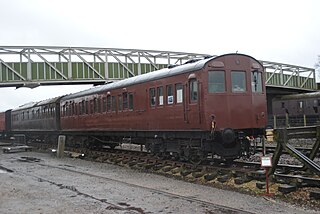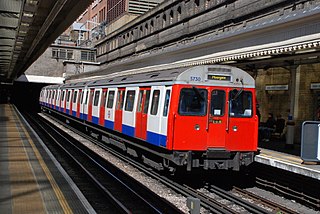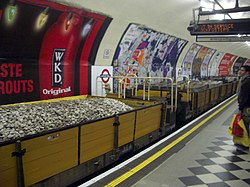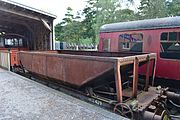
Metro-Cammell, formally the Metropolitan Cammell Carriage and Wagon Company (MCCW), was an English manufacturer of railway carriages, locomotives and railway wagons, based in Saltley, and subsequently Washwood Heath, in Birmingham. The company was purchased by GEC Alsthom in May 1989; the Washwood Heath factory closed in 2005 and was demolished in early 2019.

The British Rail Class 482 electric multiple units were built by ABB in 1992, for use on the Waterloo & City line. The units are almost identical to the 1992 tube stock built for the Central line.

The Standard Stock title was applied to a variety of Tube stock built between 1923 and 1934, all of which shared the same basic characteristics, but with some detailed differences. This design is sometimes referred to as 1923 Tube Stock, 1923 Stock, or Pre 1938 Stock. Most of the Standard Stock was built to replace the first generation of "Gate Stock" Tube trains or to provide additional trains for extensions built in the 1920s and early 1930s. Standard Stock cars consisted of motor cars, with a driver's cab, behind which was a "switch compartment" occupying approximately one-third of the length of the car, plus trailer cars and "control trailers", with a driving cab but no motor. All were equipped with air operated sliding doors. The guard's door on the earlier trains was a manually operated, inward-opening hinged door.

The T Stock was a series of electric trains originally built in various batches by Metropolitan-Vickers and the Birmingham Railway Carriage and Wagon Company for the Metropolitan Railway in 1927–31 for use on electric services from Baker Street and the City to Watford and Rickmansworth, though rarely some worked on the Uxbridge branch.

The Q Stock consisted of various District line trains, built from 1923 until the mid-1930s, originally built with manually operated sliding doors. Following conversion to air operated doors, the trains became collectively known as Q Stock. Given that five different types of rolling stock were converted to Q Stock, the resulting hybrid trains looked bizarre - with the older carriages having flat sides and clerestory roofs, whilst the Q38 had flared sides at floor level.

The London Underground O and P Stock electric multiple units were used on the London Underground from 1937 to 1981. O Stock trains were built for the Hammersmith & City line, using metadyne control equipment with regenerative braking, but the trains were made up entirely of motor cars and this caused technical problems with the traction supply so trailer cars were added. P Stock cars were built to run together with the O Stock cars now surplus on Metropolitan line Uxbridge services. The trains had air-operated sliding doors under control of the guard; the O Stock with controls in the cab whereas the P Stock controls in the trailing end of the motor cars. The P Stock was introduced with first class accommodation, but this was withdrawn in 1940.
Diesel locomotives have seen limited use on the London Underground, largely because exhaust gases cannot be discharged when the vehicles are working in tunnels. A prototype diesel engine numbered DEL120 was built in 1939 from two 1915 stock motor cars, which was expected to be part of a batch of ten, but experience with battery locomotives showed that these were a better alternative. Three 0-6-0 diesels (DL81-DL83) were obtained in 1971, to replace the last steam engines, but were too short to operate the signalling system, and too heavy for some of the bridges. In 1996, fourteen diesels were supplied by Schöma of Germany, which were used during the construction of the Jubilee line tunnels. They were fitted with exhaust scrubbers, to enable them to work in the tunnels. To speed up track renewals on the subsurface lines, Class 66 locomotives have been hired in since 2006 to handle permanent way trains, but again suffer from being too heavy for some of the bridges. Because they are not fitted with tripcock safety devices, and pull trains much longer than the signalling system is designed for, they are restricted to slow speed running.

The London Underground 1962 Stock was a type of London Underground tube train built for use on the Central line. They were used on the Central line between 1962 and 1995, with some later being transferred to the Northern line where they were used until 1999.

The London Underground C69 and C77 Stock, commonly referred to as the C Stock, was a type of sub-surface rolling stock used on the Circle, District and Hammersmith & City lines of the London Underground between 1970 and 2014. They were replaced by the S7 Stock.

The London Underground 1967 Stock was a type of deep-level train that operated on the Victoria line of the London Underground from the line's opening on 1 September 1968 until 30 June 2011. It was also used on the Central line between Woodford and Hainault between 21 February 1968 and 1984, as the same automatic train operation (ATO) system was used on both lines.

London Underground battery-electric locomotives are battery locomotives used for hauling engineers' trains on the London Underground network where they can operate when the electric traction current is switched off. The first two locomotives were built in 1905 for the construction of the Great Northern, Piccadilly and Brompton Railway, and their success prompted the District Railway to buy two more in 1909, which were the only ones built to the loading gauge of the subsurface lines. Following this, a number of battery vehicles were built by converting redundant motor cars, with the batteries placed in the unused passenger compartment. One exception to this was made by the City and South London Railway, who used a trailer car to hold the batteries, and wired them to a separate locomotive.
London Underground L Stock was a clerestory-roofed rail stock built for the District line in 1932 and subsequently absorbed into the London Underground Q Stock, being redesignated Q31 Stock.
London Underground K Stock is a clerestory-roofed rail stock built for the District line in 1927. It was subsequently absorbed into the London Underground Q Stock.

The London Underground Q Stock were trains used on the District line of the London Underground. First introduced in 1938, these electric multiple units were formed from cars built between 1923 and 1935 and new purpose-built cars, and fitted with electro-pneumatic brakes and guard controlled air-operated doors. Trains were made up from cars of different ages with differing appearances, the older ones with clerestory roofs and the newer ones with flared sides. Some units were withdrawn in the early 1960s, although six- and eight-car trains remained on the District line with use gradually diminishing to peak hours only, and four car units worked the East London line until 1971.

Ealing Common Depot is a London Underground railway depot on the District line, located between Acton Town and Ealing Common stations in west London, England. It is the oldest of the main depots on the Underground, having been built in 1905, when the District Railway was upgraded for electric traction. All depot facilities were moved there from Lillie Bridge Depot, and it was known as Mill Hill Park Works. It subsequently became Ealing Common Works, and its status was reduced to that of a depot in 1922, when Acton Works was opened, and took over responsibility for all major overhauls. Most of the functions of Acton Works were devolved back to the depots, including Ealing Common, in 1985.
London's Metropolitan Railway (MR) amalgamated with other underground railways, tramway companies and bus operators on 1 July 1933, to form the London Passenger Transport Board (LPTB); the MR became the Board's Metropolitan line.

Departmental locomotives on the London Underground consist of vehicles of a number of types which are used for engineering purposes. These include battery locomotives, diesel locomotives, electric locomotives, sleet locomotives, pilot motor cars and ballast motor cars. Details of the first four types are covered elsewhere. Pilot motor cars and ballast motor cars are generally vehicles which have been withdrawn from passenger service, but continue to be used by the engineering department. Pilot motor cars are used to move other vehicles around the system, while ballast motor cars are used to haul ballast trains and engineering trains.

Ruislip depot is a London Underground traction maintenance depot on the Central line, and is situated between the stations of Ruislip Gardens and West Ruislip in the London Borough of Hillingdon. The depot is accessible from both ends, and was built for the Central Line extensions under the 1935-1940 New Works Programme. It was nearly completed by 1939, when the outbreak of the Second World War prevented further work. It was used as a factory for anti-aircraft guns during the war, and was finally opened in 1948. The main car shed has 16 tracks, and there is also a three-track car cleaning shed.

Although the railway network in Great Britain has some of the smallest loading gauges in the world, the vast bulk of it is still capable of operating full sized vehicles. However, British Rail, together with its predecessors and successors have, on occasion, been required to operate passenger trains to an even smaller loading gauge and have, as a consequence, obtained rolling stock identical to that of the "deep tube" lines of London Underground; these are lines built using the tunneling shield method, that were, by necessity, smaller than those lines built using the cut-and-cover method. In 1892, a Parliamentary Committee headed by James Stansfeld recommended that such lines be in tunnels with a minimum diameter of 11 ft 6in. Two routes operated by British Rail required the use of such deep-tube rolling stock, the Waterloo & City Line in London, and the Island Line on the Isle of Wight.

Acton Works is a London Underground maintenance facility in West London, England. It is accessed from the District line and Piccadilly line tracks to the east of Acton Town station, and was opened in 1922. It was responsible for the overhaul of rolling stock, and gradually took on this role for more lines, until the formation of the London Passenger Transport Board in 1933, when all major overhauls of underground vehicles were carried out at the works. By 1985, when rolling stock had become more reliable and maintenance intervals had increased, this function was devolved to depots on each line. Subsequently, Acton continued to overhaul major items after they had been removed from trains at the depots, and tendered for work, which included the conversion of the A60 Stock to One Person Operation. It is likely to be reorganised and expanded to house the departments displaced from Lillie Bridge Depot which is being demolished as part of the redevelopment of Earls Court Exhibition Centre.























